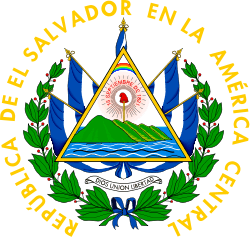Religion in El Salvador
El Salvador's approximately 6.1 million inhabitants (July 2013) are mostly Christian.[2] Evangelicals are growing rapidly.[3]
Religious affiliation
| Denomination | Percent |
|---|---|
| Assemblies of God | 21.3 |
| Bautista Amigos de Israel | 11.5 |
| Elim | 9.0 |
| Church of God | 7.0 |
| Baptist | 7.0 |
| Profética (Prophetic) | 6.1 |
| Pentecostal | 4.5 |
| Apóstoles y Profetas (Apostles and Prophets) | 3.9 |
| La Luz del Mundo | 3.7 |
| Jehovah's Witnesses | 3.1 |
| Adventists | 2.9 |
| Príncipe de Paz (Prince of Peace) | 2.2 |
| Mormons | 2.0 |
| Others | 12.6 |
| No denomination | 2.2 |
There is some debate about percentages, the Institute of Public Opinion of the University of Central America in May 2013 found 51% of the population as Roman Catholics, and 33% as Protestant, 14% as not having a religion and the remainder (less than 2%) being Jehovah's Witnesses, Hare Krishnas, Muslims, Jews, Buddhists, Latter-day Saints (Mormons), and members of indigenous religions.[2] However Latinobarómetro in 2013 found 54% were Catholic, 31% Protestant, 10% atheist/agnostic/not religious, 4% other religions, and 1% did not answer.[1] It also found in 1996 that 67% of the population considered themselves Catholic and 15% Protestant.[1]
Denominations
Mision Cristiana Elim Internacional is a large pentecostal denomination started in El Salvador. It claims that its main church in San Salvador has 120,000 attending.[5] The Assemblies of God claim 285,226 members (2007).[6]
The Mormons claim 120,317 people in 164 congregations and 1 temple (2015)[7] which if correct would be just under 2% of the population. An IUDOP study in 2009 found that Mormons were 2% of the Protestants they surveyed or about .8% of the total population.[4] They started evangelizing in El Salvador in 1951.[7]
The Anglican Church in El Salvador (a diocese of the province of the Anglican Church in Central America) claims 6,000 members in 18 congregations.[8] The Baptist Association of El Salvador claims 4,427 members[9] and the Salvadorean Lutheran Synod about 15,000 in 68 congregations,[10]
Irreligion
| Year | % of Salvadoran Population[11] | Pop of Salvadoran Population | ||
|---|---|---|---|---|
| 1995 | 9 | | 517,320 | |
| 1996 | 13 | | 754,910 | |
| 1998 | 18 | | 1,061,100 | |
| 2000 | 16 | | 953,444 | |
| 2001 | 13 | | 778,050 | |
| 2005 | 17 | | 1,032,410 | |
| 2007 | 14 | | 857,222 | |
| 2009 | 19 | | 1,174,770 | |
| 2010 | 28 | | 1,741,040 | |
| 2011 | 14 | | 875,840 | |
| 2012 | 18 | | 1,133,460 | |
| 2015 | 17 | | 1,092,930 | |
See also
- Demographics of El Salvador
- Roman Catholicism in El Salvador
- Protestantism in El Salvador
- The Church of Jesus Christ of Latter-day Saints in El Salvador
- Islam in El Salvador
- Judaism in El Salvador
References
- 1 2 3 "Las religiones en tiempos del Papa Francisco" (PDF) (in Spanish). Latinobarómetro. April 2014. pp. 6, 13. Archived from the original (pdf) on 4 April 2015. Retrieved 4 April 2015.
- 1 2 "International Religious Freedom Report for 2013". U.S. State Department. Retrieved 2015-04-25. For percentages it quotes the Institute of Public Opinion of the University of Central America
- ↑ Stephen Offutt, New Centers of Global Evangelicalism in Latin America and Africa (Cambridge University Press, 2015) focuses on El Salvador and South Africa.
- 1 2 "La religión para las y los salvadoreños" (PDF). Instituto Universitario de Opinión Pública Boletín de prensa (in Spanish). San Salvador, El Salvador: r: Universidad Centroamericana José Simeó. 24 (4): 2. 2009. Retrieved 28 April 2015.
- ↑ "Células". Elim Mision Cristiana. Retrieved 26 April 2015.
- ↑ Triplett, Don. "King's Castle 24/7 Prayer Fortress". Assemblies of God World Mission. Retrieved 26 April 2015.
- 1 2 "El Salvador". Newsroom. The Church of Jesus Christ of Latter-day Saints. Retrieved 26 April 2015.
- ↑ "Iglesia Anglicana de El Salvador". Retrieved 26 April 2015.
- ↑ "Baptist Association of El Salvador". World Council of Churches. Retrieved 26 April 2015.
- ↑ "Salvadorean Lutheran Synod". World Council of Churches. Retrieved 26 April 2015.
- ↑ The Latin American Socio-Religious Studies Program / Programa Latinoamericano de Estudios Sociorreligiosos (PROLADES) PROLADES Religion in the Americas by country
Further reading
- Stephen Offutt, New Centers of Global Evangelicalism in Latin America and Africa (Cambridge University Press, 2015) focuses on El Salvador and South Africa. online review

